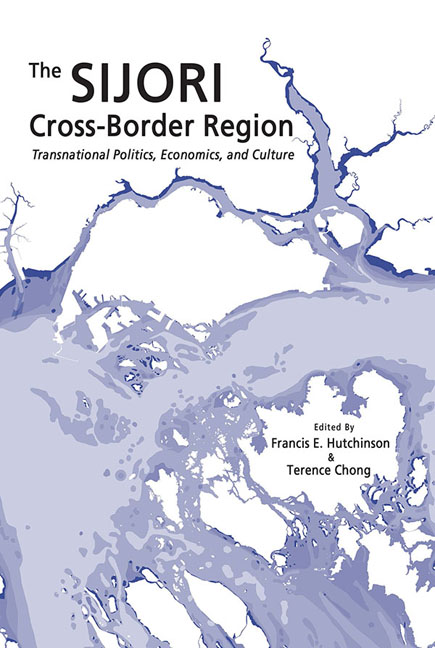Book contents
- Frontmatter
- Contents
- List of Maps
- List of Tables
- List of Figures
- Foreword
- Acknowledgements
- Contributors
- Abbreviations
- Introduction
- Section I Understanding the Whole
- Map2
- 2 The Population of the SIJORI Cross-Border Region
- 3 The SIJORI Cross-Border Region as an Economic Entity in 1990 and 2012, and Perspectives for 2030
- Section II Policy and Politics
- Section III Cross-Border Social and Cultural Communities
- Section IV Formal and Informal Economies
- Conclusion
- Appendix
- Sources for the SIJORI Maps
- Index
2 - The Population of the SIJORI Cross-Border Region
from Section I - Understanding the Whole
Published online by Cambridge University Press: 22 July 2017
- Frontmatter
- Contents
- List of Maps
- List of Tables
- List of Figures
- Foreword
- Acknowledgements
- Contributors
- Abbreviations
- Introduction
- Section I Understanding the Whole
- Map2
- 2 The Population of the SIJORI Cross-Border Region
- 3 The SIJORI Cross-Border Region as an Economic Entity in 1990 and 2012, and Perspectives for 2030
- Section II Policy and Politics
- Section III Cross-Border Social and Cultural Communities
- Section IV Formal and Informal Economies
- Conclusion
- Appendix
- Sources for the SIJORI Maps
- Index
Summary
INTRODUCTION
Understanding the population dynamics of a region is crucial to any examination of its socio-economic development. This chapter examines the population dynamics in the SIJORI (Singapore, Johor and the Riau Islands) Cross-Border Region with a focus on the key years of 1990, 2010 and 2030. Official data is used for 1990 and 2010, and projections are made for 2030.
The accuracy and relevance of any statistical analysis depends on the data used. Therefore, understanding the sources and quality of the data is the first important step towards interpreting the demographic situation in any country or region. As SIJORI is an aggregation of three countries with different systems of collecting and publishing statistics, this chapter will devote some space to making these statistics consistent and comparable, as well as explaining their implications. The data will provide perspectives on the region's total population and its distribution within it from 1990 to 2010, as well as demonstrate how SIJORI will change demographically with respect to its population size, age-sex-ethnic composition, and geographical distribution by 2030. The projections for the year 2030 will be based mostly on official government projections, with some modifications. Three main demographic indicators will be examined, namely, fertility, mortality, and migration in SIJORI, followed by a discussion of the population's sex ratio, as well as age and ethnic composition from 2010 to 2030. This chapter will conclude with an evaluation of the implications of the changes in SIJORI's demographic characteristics.
TRANSIENT POPULATION AND POPULATION PROJECTION
There are two ways to measure population — de facto and de jure. De facto measurements entail counting all individuals who happen to be present in a given area at a given time. De jure refers to the “usual residence” of individuals by applying a minimum period of time in an area before they are recorded as living there. Individuals who do not meet the minimum period of stay are considered part of the “transient population” and are not recorded in the population census.
Singapore, Malaysia and Indonesia follow the de jure approach, albeit with some differences. The threshold in Johor and the Province of Riau Islands (hereafter called PRI) is six months. In these cases, individuals who stay at least six months or who intend to stay for more than six months are recorded as part of the population (Department of Statistics Malaysia 2005; Badan Pusat Statistik 2009).
- Type
- Chapter
- Information
- The SIJORI Cross-Border RegionTransnational Politics, Economics, and Culture, pp. 41 - 65Publisher: ISEAS–Yusof Ishak InstitutePrint publication year: 2016



